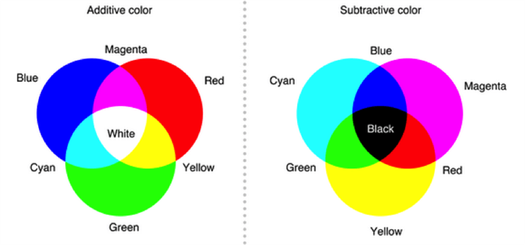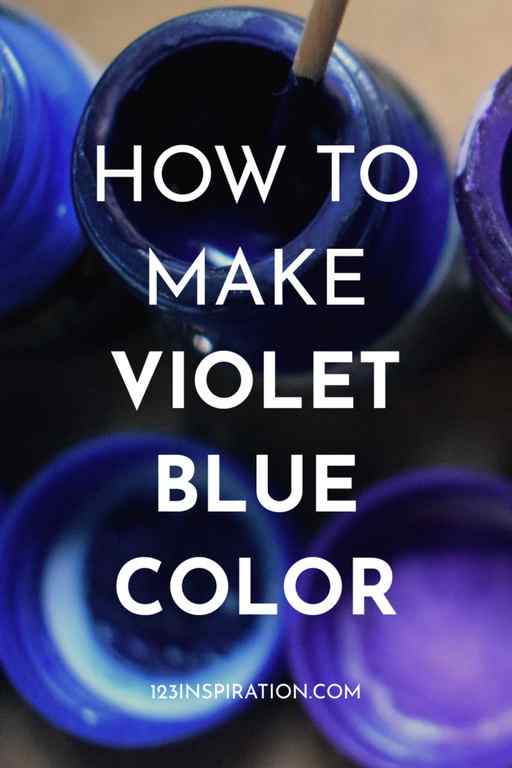In interior design, blue-violet is often used for details in rooms, particularly in furniture, carpets, and artwork.
What Colors Make Blue Violet? What Two Colors Make Blue Violet (Updated 2023)
Today, we are going to take a closer look at what colors make blue-violet. It is incredibly easy to mix paints and make new colors to use in your art.
Aside from the primary and secondary colors, you can also create tertiary colors like blue-violet.
As an artist, it is important to know how to create different colors in the color wheel.
When you think about the color blue violet, what comes to mind? Since the color is somewhat dark, resembling violet, you may think of flowers such as Violas or Verbena.
As we discuss this, you will also start to understand how colors react to one another and how mixing them will make way for a whole new set of colors you can use for your art.
What Two Colors Make Blue Violet
As you know, blue-violet is a tertiary color. It is created by mixing two colors: blue and violet.
This is a given based on the name, but there are also some other ways to create this color.
For instance, you can mix straight red with blue, ensuring to add more blue than red.

This works because mixing primary colors red and blue will create violet. You then add more blue to make blue-violet.
Here is a visual chart that easily explains how you can make the tertiary color blue-violet.
What Happens When You Mix Colors
Most colors you see in paintings do not come right out of the tube. Although the varieties of colors available on the market are wide, you can always create new ones by color mixing.
Artists modify the value and intensity of colors by mixing other colors together. One can tone down colors by adding more neutral colors or intensify hues by adding brighter colors.
More intense colors will draw more attention when surrounded by lower-intensity colors. This is what creates the dynamic of hues, emphasizing some details in paintings and playing down others.
If you are creating assorted swatches of blue-violet, you need the colors violet, red, and blue to add depth to the painting.
In addition, understanding how complementary and analogous colors will help you intensify shades or add sharp contrast.
Generally, there are two types of color mixing: additive and subtractive.
Additive mixing of colors means you create new colors by adding wavelengths of light.
Typically, this mixing is used for combining primary colors red, yellow, and blue. If you overlap all three colors in an equal mixture, you will get white.

On the other hand, subtractive color mixing means you create new colors by filtering out wavelengths, eventually leading to black.
For example, if you combine cyan, magenta, and yellow, you can make black.
What is the Color Violet Blue?

Violet blue is a beautiful color. Blue and purple both rank high among people’s favorite colors. And while violet blue is less common, it’s still a beautiful shade. Violet blue is a cool temperature color. It’s sophisticated and a little mysterious. It can also look feminine without being overly sweet – it’s more subtle than pink, for example. This color has the calming qualities of blue and the magic and mystique of purple. The hex code for violet blue is #8A2BE2. That’s helpful to know if you’re a graphic designer or digital artist. Keep reading to find out how to make blue violet color for yourself.

Violet blue is an excellent color to use in your home due to its visually appealing qualities. It pairs well with colors like gray, blue, and green. Or you could pair it with yellow, its complementary color, for a contrasting look. This color also looks fantastic when used in artwork or any kind of creative pursuit. It’s eye-catching and carries a lot of meaning. So, it’s sure to get people looking closer. And violet blue is also a popular color in branding and logos. Some huge companies like Taco Bell and Cadbury use it for a distinctive brand identity. It’s bright and bold without being too flashy. So, it gets the balance just right and is very recognizable.
The Color Wheel: Tertiary Colors

I mentioned above that violet blue is a tertiary color. But what does that mean exactly? You might be familiar with primary colors – red, blue, and yellow. But secondary and tertiary colors are less well-known, so here’s a quick refresher. We make secondary colors by mixing two primary colors together. And you can make a tertiary color by mixing a primary color with a secondary color. And if you mix all three primary colors, you’ll create a brown or black color. This is also true if you mix secondary or tertiary colors together. That’s because the colors absorb different wavelengths, so they aren’t bounced back to our eyes. So, as a result, we only see the color black. A color wheel is an essential tool for understanding how to mix colors. It displays the colors in a visual way, so you can see their similarities and differences. I would recommend that all artists get comfortable with a color wheel. It’s also handy to refer to when you’re unsure about which color to use. If you look at the color violet on the color wheel, you’ll notice two colors next to it. These are violet blue and violet red. Each of these colors is what you’ll get when you mix violet with the primary colors blue or red. They look similar but have a different undertone or hue. While violet blue is a cool color, violet red is warmer, as red is on the warm end of the color spectrum.

You can make violet blue by mixing the colors blue and violet. It sounds simple, and it’s pretty easy to do. Blue is a primary color, so it’s essential for mixing paints. Violet is the secondary color you get when you mix blue and red. This shade is often called true purple, as it contains equal amounts of red and blue. So, it doesn’t have a color bias. Violet sits exactly between red and blue on the color wheel. When you mix a primary and secondary color, you create a tertiary color. You need to take equal parts blue and violet to make blue-violet. Then, it will sit between blue and violet on the color wheel. But of course, you can experiment with different ratios to suit your needs. You might want to create a blue color with just a touch of violet (or vice versa). In that case, you could use 70% violet to 30% blue paint. You will make a purple shade with a blue undertone. Or swap them around for a shade that has more blue. The more you experiment with color mixing, the more confident you will become.
Mixing Paints to Make Violet Blue Color

If you’re using a paint set, you might have limited color choices. And even if you buy individual paint tubes, you might not find the exact shade you need. That’s why I recommend learning how to mix your own paints. It will make you more confident and experienced as an artist. Plus, you’ll be able to make a wide range of shades using what you have to hand. A color mixing chart can come in handy when mixing paints. Check out my article here to learn how to DIY your own color mixing chart. You can make almost any other color using the primary colors alone. But it’s handy to have some secondary colors to mix with them, as it will save you a lot of time. Plus, you’ll need black and white paint to adjust the colors. That way, you can make your paints lighter or darker. And you’ll find it easier to get your desired colors for any painting. When mixing violet blue, you’ll need blue paint and violet paint. It’s also helpful to have a palette for mixing colors. And finally, a thin paintbrush is essential. Then, you can take equal amounts of blue and violet paint and pour them onto your palette. Mix thoroughly with your paintbrush until they are smooth and you have an even color. And it’s as simple as that. You’ve mixed your own violet blue paint and can use it in your artwork. If you’re more of a visual learner, you can watch this short video to see how it’s done:
Mixing Different Shades of Violet
When you mix red and violet, you’ll create red-violet. This shade looks like the name suggests, a rich reddish-purple shade. Some call it magenta, but it also has berry tones. As for color temperature, it’s a lot warmer than the violet blue color. If you want to create a dark violet color, you can add black paint to your violet. But make sure to go easy with the black paint. It can quickly overwhelm your violet paint and make it too dark.  In contrast, you can add some white paint to lighten your violet color. The same goes for violet blue if you want to create a lighter tint. Add drops of white paint and mix well until you get the desired shade. You can add pink to make your violet color more feminine. This will create a flowery, fun shade that’s nice to use in your paintings.
In contrast, you can add some white paint to lighten your violet color. The same goes for violet blue if you want to create a lighter tint. Add drops of white paint and mix well until you get the desired shade. You can add pink to make your violet color more feminine. This will create a flowery, fun shade that’s nice to use in your paintings. 
Late Summer Landscape using the Primary SET 2

See part II of this blog post for a step by step tutorial on how to paint a Late Summer Landscape using only the colours in the Primary Set 2 – Raw Sienna, Light Red and French Ultramarine.
Summary
To summarise, getting to know your primary colours is the best place to start developing confidence with colour mixing. Try the colours suggested here and then explore a few of your own. Occasionally you might find it impossible to get the colour you want by mixing.
Certain colours of a more exotic hue such as Turquoise, Viridian or a very bright purple may be better straight from the tube or pan, but I recommend trying to get the most out of just a few colours first.
About Paul Weaver
Paul Weaver is a full-time artist, tutor and demonstrator. His primary inspirations are light and atmospheric effects. Townscapes, markets and the bustle of the city are favourite subjects, as well as landscape, marine and coastal scenes. He currently specialises in watercolour, but also enjoys working in oil, acrylic and line and wash.
He is a regular contributor for ‘The Artist’ magazine, a demonstrator for St Cuthbert’s Mill and a fully-elected member of the Pure Watercolour Society.
He regularly visits art groups across the South West for demonstrations and workshops. For further examples of Paul’s work and details of his painting courses and holidays, please visit his website at www.paulweaverart.co.uk
The website has an extensive shop with a wide selection of original paintings for sale, cards and Paul’s bespoke, ‘Freestyle’ watercolour brush, as well as watercolour tutorial videos to view online.
All work ©2020 Paul Weaver





